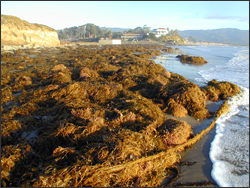
Have you ever walked along a California coast and wondered about all of the kelp washed-up on shore? In winter when storms are more frequent, giant kelp is regularly washed ashore. University of California, Santa Barbara researcher David Reed and colleagues recently found that it is the wave action from these winter storms that is the most destructive force for the giant kelp forests—more so than temperature, nutrients, and kelp-eating sea urchins. Using free Landsat 5 data, Reed and his team discovered that the amount of kelp lost in central California was double that lost in southern California. They have postulated that the heavier wave action along California’s central can be the only reason for this difference.
Reference:
Reed, D.C., A.Rassweiler, M.H.Carr, K.C.Cavanaugh, D.P.Malone, and D.A.Siegel (2011). Wave disturbance overwhelms top-down and bottom-up control of primary production in California kelp forests. Ecology, November, Vol. 92, No. 11: 2108-2116
(doi: 10.1890/11-0377.1)
Waves mightier than sun, otter or urchin: storm disturbance shapes California kelp forests, by Liza Lester for Ecotone. [external link]

Be Part of What’s Next: Emerging Applications of Landsat at AGU24
Anyone making innovative use of Landsat data to meet societal needs today and during coming decades is encouraged to submit and abstract for the upcoming “Emerging Science Applications of Landsat” session at AGU24.





